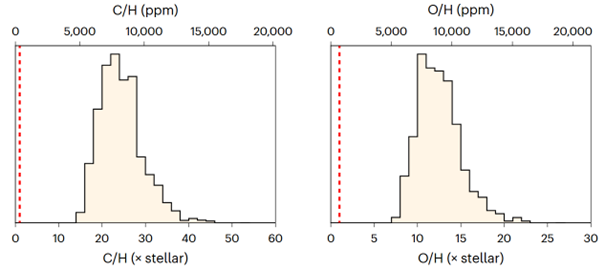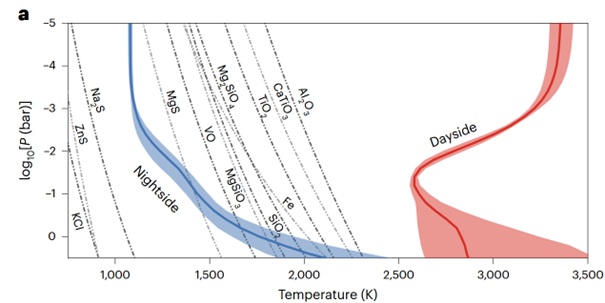Continuous Observations of WASP-121b Reveal Complex Formation History

Ultra-hot Jupiters (UHJs) are a class of exoplanets that are both massive and extremely hot, making them prime targets for atmospheric characterisation. Their high temperatures cause their atmospheres to expand significantly, making them easier to observe from Earth.
Among these, WASP-121b has garnered particular as it exhibits exceptionally high temperatures, even by UHJ standards. This is because the planet is tidally locked, much like our Moon, and as such only one of its hemispheres will ever face towards the sun, heating the dayside up to around 3000°C. Furthermore, it exhibits a favourable orbital alignment and short orbital period of just over one day, which enable frequent and well-observed transits across its host star.
Recent investigations led by Thomas Evans-Soma uncovered new and exciting details concerning the dynamics and composition of WASP-121b’s atmosphere. The study leverages data collected by the Near-Infrared Spectrograph (NIRSpec) on the James-Webb Space Telescope (JWST). Spectra were collected every few minutes during a continuous, 38-hour observation window, covering multiple orbital phases of WASP-121b.

Due to the strong variation in atmospheric conditions across the day- and nightsides, each individual spectrum is difficult to interpret, as we are observing some blended emission filtered through two very distinct media. However, by observing how this spectrum changes during with orbital phase, and considering the planet’s changing orientation along our line-of-sight, the team are able to differentiate between spectroscopic features belonging to the day- and nightsides, giving a clear and detailed look at the composition of each.
Using this approach, the team were able to confidently detect multiple molecules present in the atmospheres, including water (H2O), Carbon Monoxide (CO) and Silicon Monoxide (SiO) on the dayside, as well as Methane (CH4) on the nightside. A major result was that these molecules, particularly carbon, oxygen, and silicon, are present at super-stellar abundances; far higher than what is found in the host star. This could not have been accomplished by early-gas accretion alone. Instead these materials must have been acquired later, possibly during a late-stage heavy bombardment of rocky planetesimals, enriching the surface with refractory materials.

Furthermore, on the dayside, the Pressure Temperature (P-T) profile becomes inverted at a certain altitude. This is quite unusual behaviour as temperature is expected to fall with altitude, unless specific complex materials are present at certain altitudes and drive warming. Indeed, the team suggests that a blanket of SiO in the upper atmosphere is responsible for absorbing stellar radiation, and heating. This also marks the first concrete detection of SiO, after many years of theories and tentative evidence for its presence.
Looking ahead, future investigations should seek to extend similar phase-resolved observations to a broader sample of exoplanets. Additionally, the team are keen on improving their current models by refining their approach to vertical mixing of particles, well as better account for cloud formation.
--
Journal Source: T. Evans-Soma et al., SiO and a super-stellar C/O ratio in the atmosphere of the giant exoplanet WASP-121 b, Nature Astronomy, (2025), DOI: http://dx.doi.org/10.1038/s41550-025-02513-x
Cover Image Credit: ESA/Hubble
